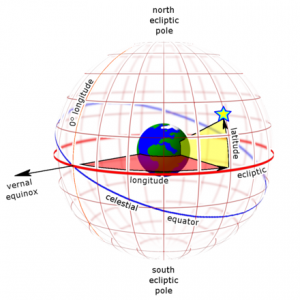Ecliptic coordinate system

The Ecliptic coordinate system is a celestial coordinate system commonly used for representing the positions and orbits of Solar System objects. Because most planets (except Mercury), and many small Solar System bodies have orbits with small inclinations to the ecliptic, using it as the fundamental plane is convenient. The system's origin can be either the center of the Sun or the center of the Earth, its primary direction is towards the vernal (northbound) equinox, and it has a right-handed convention. It may be implemented in spherical coordinates or rectangular coordinates.
The celestial equator and the ecliptic are slowly moving due to perturbing forces on the Earth, therefore the orientation of the primary direction, their intersection at the Northern Hemisphere vernal equinox, is not quite fixed. A slow motion of Earth's axis, precession, causes a slow, continuous turning of the coordinate system westward about the poles of the ecliptic, completing one circuit in about 26,000 years. [1]
From antiquity through the 18th century, ecliptic longitude was commonly measured using twelve zodiacal signs, each of 30° longitude, a practice that continues in modern astrology. The signs approximately corresponded to the constellations crossed by the ecliptic. Longitudes were specified in signs, degrees, minutes, and seconds. For example, a longitude of Leo 19° 55′ 58″ is 19.933° east of the start of the sign Leo. Since Leo begins 120° from the vernal equinox, the longitude in modern form is 139° 55′ 58″.

